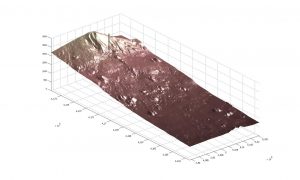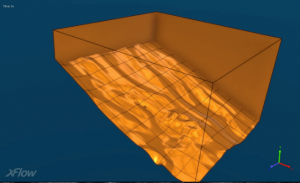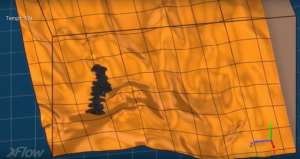‘Project of the Year’ is an annual contest held by Dassault Systèmes where students from around the world are invited to submit projects created with Dassault Systèmes products and software. Winners are chosen by votes users and an overall winner is chosen by a jury at Dassault Systèmes headquarters.
This interview with SIMULIA winners, Amélie and Clémentine, was conducted by SIMULIA Academic Programs Specialist, Yannick Margani. They used XFlow for their project, “Numerical Simulation of a lava flow from Mount Etna.”
*Update: These two students also just won the academic poster contest we held at the Modeling and Simulation conference in Paris!
Please briefly introduce yourself and your education background?
Hello my name is Amélie and I am 20 years old. After a scientific diploma at the French school of Shanghai and granting access to university studies, I went back to France and joined UniLaSalle in Geosciences and Environment.
Hello! I am Clementine and just like Amélie I joined the engineering School UniLaSalle Beauvais after a scientific diploma with a Well Mention.
Can you please describe the project you worked on and what motivated you to do it?
Our project consists of the numerical simulation of a lava flow from Mount Etna in Sicilia. It is an undergraduate thesis that is led on one academic year by a binomial of students.
We decided to lead this project together because we are both interested in the numerical simulation field. Our idea was to combine these new technologies with geosciences and more particularly with volcanology. We showed this project to two of our teachers, Mr. Hervé LEYRIT who is an university lecturer and researcher specialized in volcanology, and Mr. Julien DUQUENNOY who is the Head of the GéoLab UniLaSalle (The GeoLab is an innovation center that provides technological tools to UniLaSalle students to develop educational projects or research in geosciences). Once the project was accepted by them and we defined it more precisely, we took a three-week field trip above Mount Etna in September 2018.
The purpose of our project was to numerically simulate a lava flow in three dimensions with the model of an eruption that happened 18 years ago, in 2001.Thanks to the different results of simulations we obtained, we could confront them to the real lava flow in order to compare simulations to reality. We could modify parameters on the software in order to improve the results and to make it even more precise. The final goal would be to foretell or anticipate future lava flows that may happen in order to protect populations and/or habitations.
Please describe in a few sentences your simulations: the methods used, the physics, etc.
The first step was to discover, learn, and start using XFlow, which was new software for both of us. This work consisted in reading scientific articles about the eruption and about the different physical methods that manage XFlow. Computational Fluid Dynamics (CFD) are all about fluid mechanics with the Lattice-Boltzmann method, turbulent viscosity notions, speed unit, etc.
The field trip allowed us to collect samples and to define physical and chemical parameters of the lava. Once we were back at school, we started the numerical part of our undergraduate thesis. First of all we searched in the bibliography the numerical surface of our volcano before the eruption of 2001 in order to simulate our flow above it. Then we exported this surface in the CATIA software to apply some modifications on it in order to make it compatible with XFlow, and finally we exported it in XFlow with all the parameters that corresponded with our trachybasaltic lava.

Have you faced technical challenges? Any limitations?
We have faced technical challenges according to the size of our numerical shape. As a matter of fact, our lava flow extends over 3.7 miles, which is too large for the software. So we decided to concentrate our simulation on the first kilometer of the flow. Then we could obtain results that can be representative of what the fluid flow should be in the software.
Moreover, XFlow is currently used for the simulation of low viscosity fluids (like water or air). That was a challenge to try to properly simulate a flow with a super high viscosity like our lava.

Before starting this project, would you have thought that numerical simulation could help you understand the phenomenon?
At the beginning, we absolutely didn’t know if the results would be in keeping with what we had seen during the field trip, because of the super high viscosity of the lava. Once we realized that we had some promising results but required lots of modifications in order to agree with the reality, we decided to improve our techniques and refine the parameters of the simulation fields. The more the results appeared, the more excited we were with the idea of pursuing the simulation work with XFlow.

What were the advantages of using simulation in your project?
Currently, Computational Fluid Dynamics allows the study of the evolution of a fluid inside a virtual environment. This has many advantages such as reducing time and costs in comparison with analogic simulations, for example. Moreover, using numerical simulation in our project allowed us to understand and display in a new way a real physical phenomenon. It also permitted us to approach volcanology in a different way than usual.
Numerical simulations is not part of your training curriculum. How did you learn?
We had the chance to meet Yannick Margani from DS SIMULIA who came at UniLaSalle for an entire day in order to teach and initiate us in XFlow. In addition, Jean Marie Vient, a Master 2 student in geology at UniLaSalle, who had already worked with this software, was able to help us at the beginning of the year.
Why did you choose XFlow over other simulation products?
We choose XFlow rather than other simulation software because it was a part of our interest to make some research about the panel of application of such a software. Indeed, that was one of the first times that XFlow was used to simulate a magmatic flow. The research work is one part of the project that we were really interested about. Moreover, we had easy access to it thanks to the Geolab and 3DSAcademy partnership.
What about project continuation?
This project has been chosen by two new students for their undergraduate thesis. They will work starting from our results and analysis and will continue the simulations and perhaps skip to other problems linked to this same subject.
Some new recent developments in the 3DEXPERIENCE platform make that simulation possible with a RANS method (Reynold Average Navier Stokes). This is promising!

Check out the video from the GeoLab!

